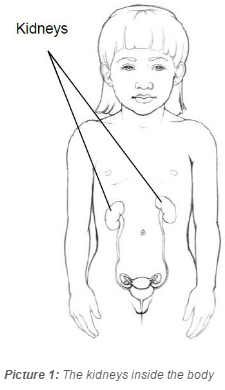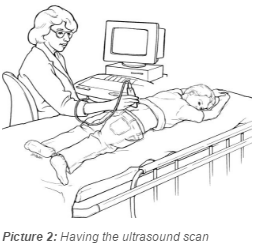Kidney (Renal) Biopsy
![]()
A kidney biopsy (BI op see) is the removal of two or three tiny pieces of tissue from the kidney (see Picture 1). The tissue is looked at under a microscope. This test is done to find out the cause and the severity of kidney disease. The word renal means something that involves the kidneys.
How to Prepare for the Test

Your child will be admitted to the hospital in the morning on the day of the biopsy. If your child did not go to Pre-Admission Testing (PAT), blood tests will be done early in the morning after he or she is in the hospital room.
A parent or legal guardian MUST be present for the start of the biopsy and stay at the hospital during the whole test.
-
If your child is ill, especially with a fever, cough, or stuffy nose, the biopsy may need to be rescheduled. If you are concerned, call your child’s kidney doctor (the nephrologist)’s office to discuss this.
-
Your child should not wear contact lenses, makeup, fingernail polish, or removable dental gear such as retainers.
-
An IV (intravenous fluids line) will be started so fluids and anesthesia (sleeping medicine) can be given before the biopsy.
-
A nurse from the Procedure Center will call the night before your test with instructions about where to register and when to stop eating and drinking.
General Anesthesia
General anesthesia (an uhs THEE zhuh) is a way of giving medicines that can put a child into a deep sleep. This keeps the child from feeling pain during surgery.
Usually the medicines are given by an IV, with a syringe (as a shot), or breathed through a mask. Your child’s doctor will discuss the medicines with you.
The kind of medicine the doctor will use to help you child sleep through the biopsy depends upon:
- Your child’s medical condition
- The type of procedure that is done
- How long the procedure will last.
Before the Test
Tell your child’s doctor or nurse about the following:
-
Your child’s allergies to medicines and foods
-
Your child’s recent illness or fevers
-
The last time your child ate or drank
-
Your child’s medical history
-
If your daughter knows or suspects she is pregnant
-
All medicines your child is taking (including over-the-counter or herbal products)
-
If your child has had apnea (pauses in breathing) or other breathing problems
-
Any problems your child has had with sedation or anesthesia in the past
-
If your child snores when asleep. This could be a sign of a breathing problem (sleep apnea).
The Ultrasound Test
Many children have an ultrasound test before the biopsy. If your child needs an ultrasound close to the time of the biopsy, he or she may be taken to the Ultrasound area.
- Parents may stay with their child until it is time for the biopsy.
- Your child will lie on his or her stomach on a padded table with arms raised overhead.
The technologist uses ultrasound equipment to make the image of the kidney appear on a TV screen (see Picture 2). This picture shows the doctor where to get the tissue for biopsy.
An Ultrasound Technologist will tell you where you can wait during the biopsy and will let you know when the test is over.
During the Biopsy
The anesthesia nurse and doctor will connect your child to monitors (this does not hurt). The monitors will measure breathing, heart rate, and blood pressure during the procedure. The nurse or doctor will talk to you about the medicines that will be used to make your child sleepy.
Your child will be on his stomach. Medicine to make him or her sleepy will be given through the IV, or your child may be asked to breathe a special gas through a mask, or given a shot. Once your child is asleep the doctor may need to put a tube into the windpipe to help him or her breathe and protect the lungs. The doctor will clean your child’s skin with a medicine that kills any germs.
Your child will be watched closely by an anesthesiologist (an uhs thee zee AHL uh jist) or a nurse anesthetist (an ESS thih tist). The doctor or nurse will be able to change how deeply asleep your child is during the biopsy. Your child will not feel any pain or remember the biopsy because of the sleeping medicine.
-
The doctor will use a long, thin, hollow needle to take two or three tiny pieces of tissue from the kidney through a very small (less than one-quarter inch) cut in the skin.
-
This tissue will be sent to the lab by your child's doctor so it may be looked at under a microscope.
-
The nurse anesthetist will check your child's heart rate (pulse), breathing, and blood pressure every 5 to 10 minutes after the sleeping medicine is given, until the test is finished.
-
A small bandage will be put over the biopsy site.
After the Test
-
After the biopsy your child will go to the Procedure Center to recover and wake up.
-
When fully awake, he or she will be taken back the hospital room. Your child will be allowed to eat and drink, usually starting out with liquids.
-
When your child wakes up from the sleeping medicine he may be silly, sleepy or grouchy.
-
Your child may feel sick to the stomach (nausea), have a dry mouth, sore throat, or feel cold or restless until the medicine wears off. This may take several hours. Your child’s nurse will check for these side effects and can give medicines to help with discomfort, nausea, and vomiting if needed.
-
The nurse will check your child's pulse and blood pressure often after the test and during the night. This is usually every 15 minutes for the first 2 hours, then every half hour for the next 2 hours.
-
Your child must stay in bed for at least 6 hours and maybe until the morning after the biopsy. This helps put pressure on the kidney to prevent bleeding. The bedpan or urinal must be used instead of the toilet during this period of bed rest.
-
A blood test will be done in the evening of the day the biopsy was done. Another blood test will be done the next morning.
-
All urine will be checked for blood. Please save all of your child’s urine in the container you are given.
-
The morning after the test, the doctor will examine your child and decide when he will be allowed out of bed. Activity will then be restricted to quiet play.
-
For 3 days after your child gets home, he should rest, and avoid physical activity. Encourage your child to be a “couch potato” and relax as much as possible.
-
For 2 weeks after your child gets home, heavy lifting, rough play, physical education classes and contact sports are not allowed. Avoid any activity or equipment that puts a lot of pressure on the lower back, such as safety harnesses used for rock walls and some amusement park rides.
-
It takes at least a week to get test results back from the biopsy. Your doctor will tell you the results of the test and plans for your child’s medical care.
Risks and Complications
-
Your child may have bleeding at the biopsy site or in the urine. This can usually be managed by watching the child closely. It rarely requires giving a blood transfusion or surgery.
-
Aspiration (breathing food or saliva into the lungs) can happen during the procedure. This could happen if the child eats or drinks something before the biopsy. It is very important to follow the guidelines for not eating and drinking before the biopsy. If aspiration occurs, a child could develop pneumonia and need a hospital stay.
-
Discomfort at the biopsy site is common, but it usually lasts only up to a day after the biopsy. Your child’s nurse will check for pain and give medicines to help if needed.
-
Your child’s doctor and anesthesia team will talk with you about these and other risks and complications before the biopsy.
HH-III-65 2/86, Revised 6/15 Copyright 1986, Nationwide Children's Hospital
